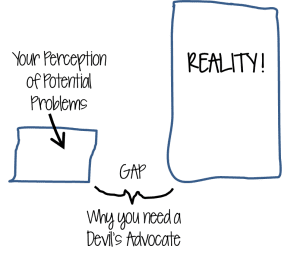
In the business world it is not uncommon for executives to appoint someone on the senior staff to serve as the Devil’s Advocate (DA) when considering a major strategic decision. The role of the DA is to look at the strategy from a critical perspective and to raise objections about flaws in the strategy before or during implementation. Basically, the DA helps prevent the execution of bad decisions and helps make course corrections once a bad decision is made.
The origins of the Devil’s Advocate (DA)
“In common parlance, a devil’s advocate is someone who, given a certain argument, takes a position they do not necessarily agree with (or simply an alternative position from the accepted norm), for the sake of debate or to explore the thought further. In taking this position, the individual taking on the devil’s advocate role seeks to engage others in an argumentative discussion process. The purpose of such a process is typically to test the quality of the original argument and identify weaknesses in its structure, and to use such information to either improve or abandon the original, opposing position. It can also refer to someone who takes a stance that is seen as unpopular or unconventional, but is actually another way of arguing a much more conventional stance. The background of this word comes from an official position within the Catholic Church, in which a canon lawyer called the Devil’s Advocate, also known as the Promoter of Faith, “argued against the canonization (sainthood) of a candidate in order to uncover any character flaws or misrepresentation evidence favoring canonization.” ~ Wikipedia
On the Incident Scene
 Let’s take the DA role on to the fireground and see how this might improve situational awareness. A commander can, for better or worse, get so emotionally invested in the strategy that it can become, quite literally, impossible to see the flaws. All you need to do is spend some time reading line-of-duty death reports or watching videos of degrading incident conditions and you’ll often see that there was time to change the strategy, yet no change was made.
Let’s take the DA role on to the fireground and see how this might improve situational awareness. A commander can, for better or worse, get so emotionally invested in the strategy that it can become, quite literally, impossible to see the flaws. All you need to do is spend some time reading line-of-duty death reports or watching videos of degrading incident conditions and you’ll often see that there was time to change the strategy, yet no change was made.
The DA is a person with a specific assignment – to evaluate command decision making and to provide feedback about why the commander should consider a different course of action or change the course of action. In order for a DA to be effective, the commander must have mental maturity, a balanced ego and be inspired to keep firefighters safe more than saving property or unsaveable lives. The DA must not be afraid to speak up.
An Advocate for Safety
The DA is an advocate for strategies that improve responder safety. The DA is not an advocate for strategies to save property at the risk of responder safety. It is critical that the DA understands that there are risks to be assumed at every emergency scene and to balance those risks against the potential rewards – to always be asking: “Is the benefit worth the risk.”
 It is also the role of the DA to ensure that the decisions of command are not CREATING risk. There is a big difference between assuming risk and creating risk. The former is inherit to the work all responders do. The latter is perpetuated by a host of influences (including, but not limited to: ego, bravado, machismo, fear, etc.).
It is also the role of the DA to ensure that the decisions of command are not CREATING risk. There is a big difference between assuming risk and creating risk. The former is inherit to the work all responders do. The latter is perpetuated by a host of influences (including, but not limited to: ego, bravado, machismo, fear, etc.).
Fear, especially, can grip responders and contribute to poor decision making. It’s not, however, the fear of injury and death that I speak of. It’s the fear of being seen as a failure, the fear of being criticized and ridiculed, and the fear of embarrassment if the incident does not end with the outcomes that we all train for (saved lives and saved property).
How to Advocate
 For most, playing the role of the DA is not an intuitive skill. Yes, I am aware there are, out there in our world, individuals who have turned Devil’s Advocacy into an art form. Those people are, for the most part, eternally pessimistic and, in general, would not serve you well as the incident scene DA. This is because you are at-risk of tuning out the perpetual DA, thinking to yourself: “Oh, that’s just old crotchety Joe being his usual pessimistic self” and dismissing their advocacy in-part or in-total.
For most, playing the role of the DA is not an intuitive skill. Yes, I am aware there are, out there in our world, individuals who have turned Devil’s Advocacy into an art form. Those people are, for the most part, eternally pessimistic and, in general, would not serve you well as the incident scene DA. This is because you are at-risk of tuning out the perpetual DA, thinking to yourself: “Oh, that’s just old crotchety Joe being his usual pessimistic self” and dismissing their advocacy in-part or in-total.
Nor do you want the “safety zealot” to serve as your DA. There are out there, in some organizations, individuals who are just over the top when it comes to safety. Now, for those who know me, you know I am a STRONG proponent for first responder safety – VERY strong. But, it is impossible to engineer, or advocate, every conceivable element of risk out of the work.
For example, a safety zealot might advocate for no interior fire attack unless there is a life in imminent danger. I would not want this person to be my DA because, so long as conditions are right to do so, I will send crews inside burning structures. I would find this person distracting because their risk tolerance is so low. Finding a balance of risk and reward is essential.
The DA should receive training on how to advocate and how to assertively communicate concerns without being confrontational. I refer you to a previous article that I wrote entitled “The Five Step Assertive Statement Process.” Enter the term in the search box on the right side of this page and it will direct you to the article. All personnel should be trained in how to deliver and accept feedback about concerns on an incident scene.
Chief Gasaway’s Advice
 On an emergency scene it is a best practice to have someone advocating for the safety of personnel. The safety officer can fill the DA role or it can be assigned to someone else. I was recently delivering a situational awareness program to a department that has the benefit of two battalion chiefs responding to structure fires. They informed me that when the second battalion chief arrives, he receives a briefing, and assumes the role of safety officer. Having a second set of eyes and ears on the incident scene is a great resource, for sure.
On an emergency scene it is a best practice to have someone advocating for the safety of personnel. The safety officer can fill the DA role or it can be assigned to someone else. I was recently delivering a situational awareness program to a department that has the benefit of two battalion chiefs responding to structure fires. They informed me that when the second battalion chief arrives, he receives a briefing, and assumes the role of safety officer. Having a second set of eyes and ears on the incident scene is a great resource, for sure.
I suggested that prior to engaging the second officer in the safety officer’s role, the commander first assign the second officer to serve as the Devil’s Advocate. “Take a walk around the incident scene and tell me why we should not be doing what we are doing.” This way, the second officer is not invested in the first officer’s plan. The second officer remains uncommitted and gives the incident scene an independent review before jumping on board the commander’s bandwagon.
If the DA affirms the strategy and the decision making seems appropriate for the conditions, the commander can move ahead with confidence and the DA then gets a formal assignment in the hierarchy of the incident. If the DA raises concerns, the commander and DA confer about what adjustments should be made before the DA assumes a more formal role in the commander’s incident hierarchy.
This process should be developed, implemented and trained for before it is ever used at an incident scene. That way, the DA knows the assignment is coming and fully understands how to execute the duties. The commander, in turn, fully expects that the DA may come back to the commander with recommendations for changing strategy or raising concerns about safety for the front-line crews.
Action Items
 Discuss the pros and cons of having a DA on an incident scene.
Discuss the pros and cons of having a DA on an incident scene.- Discuss a time when a DA raised objections at an incident scene and, as a result, the strategy was adjusted and it resulted in a safer outcome.
- Discuss a time when a DA was not assigned and no objections were raised and it resulted in a near-miss or casualty event.
_____________________________________________________
If you are interested in taking your understanding of situational awareness and high-risk decision making to a higher level, check out the Situational Awareness Matters Online Academy.
CLICK HERE for details, enrollment options and pricing.
__________________________________
Share your comments on this article in the “Leave a Reply” box below. If you want to send me incident pictures, videos or have an idea you’d like me to research and write about, contact me. I really enjoy getting feedback and supportive messages from fellow first responders. It gives me the energy to work harder for you.
Thanks,

Email: Support@RichGasaway.com
Phone: 612-548-4424
Facebook Fan Page: www.facebook.com/SAMatters
Twitter: @SAMatters
LinkedIn: Rich Gasaway
YouTube: SAMattersTV
iTunes: SAMatters Radio


Very interesting Richard, I like the way you’re put a lot of thought into this. I’ve play DA for a senior officer before a couple of times, although maybe we didn’t think about it in those terms.
PLAY BOOK.
Vegetation fire.. roughly 50 firefighters on scene, steep terrain mixed scrub and young pine. I came in about two hours after initial turnout. I took some of the comms load off the boss, after about 1/2 an hour he said… so you see what I’m doing, what do you think… which i suggested a few minor changes* and air assets.. short debate, pros/cons and yep we changed things.
MY THOUGHTS.
My boss at the time was a very smart guy and very confident in his ability, so confident that he will look at all angles if a different idea is suggested and change tactics if it makes sense, only confident thoughtful people will do that. I’ve seen people married to their tactics, or out of their depth, on these occasions how we suggest and influence change is very important.
* sometimes if we are not directly invested in what is happening it allows us to take a broader snap shot of what is happening and better project what is going to happen, this is because we have clear thinking space in our heads at any one time.